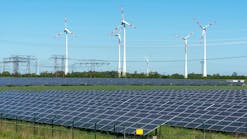A 2020 report by Pacific Northwest National Lab (PNNL) states:
Scenario analysis, granular forecasting, and options analysis are becoming increasingly important in integrated distribution system planning... More robust tools are needed that can simulate distribution systems with multiple devices, such as smart inverters and energy storage, simultaneously operating autonomously.
Rapidly changing generation sources, including residential solar and customer sited battery storage, are now impacting the infrastructure requirements to connect those sources. Studies for offshore wind interconnection locations and small modular nuclear reactors (SMRs) are being developed and impact transmission needs (ISO-NE 2019). Similarly, rapidly changing loads, whether through EV adoption and the resulting charging delivery points, time-of-use rates, or expanding cities, create difficulty in planning for future needs.
One of the tradeoffs in the field of electrical system modeling is between fidelity and scalability. Commercial products are available that can analyze system harmonics on the order of milliseconds but may not be scalable to millions of customer devices. Software on the opposite end of the spectrum may use annual peak loading on the grid. As evidenced by the Blue Cut Fire, there is limited foresight to interactions between protective relaying, distributed generation controls, and battery storage with different operating modes (NERC, 2016). Before the recent Texas grid overload, sophisticated modeling would have predicted the risk of individual generators’ constrained gas supplies based on previous events like the 2011 cold weather event (NERC 2021).
Considering the difficulty of system planning described above, a single solution is not the correct answer for planning purposes. However, a specific solution is required when picking a course of action for construction that may take years to complete. Grid planners are required to decisively pick a project scope to develop. The locational aspect of this generation and load is critical to capturing the complete requirements, costs, and implications of any plan. To achieve net-zero emissions, tools are needed for scenario analysis that supports communication between all stakeholders, including emissions estimates from future generation, providing developers data to calculate return on their investments, and the equity of rate impacts to all customers on the system.
What is already happening
Transformation in this space is constant. Government sponsored projects and Silicon Valley startups are already impacting specific problems or within regional boundaries but are still relatively separate from each other. The following recent examples demonstrate that great work is happening in system modeling.
One of the most comprehensive tools integrating software developed by multiple vendors is the HELICS project supported by the U.S. Department of Energy’s Offices of Electricity Delivery and Energy Reliability (OE) and Energy Efficiency and Renewable Energy (EERE). This effort seeks to connect the inputs and outputs of each modeling tool and serve as a data “tunnel” between the platforms for longer-term planning. While thorough, this still requires specialized modelers in each of the sub-modeling platforms and will limit its widespread use across regional stakeholders in the planning process.
Google’s 2020 announcement to move to 24/7 carbon-free energy at the time of use requires historical and real-time data of their load on an hourly basis and the energy generation on that portion of the grid at that hour. In partnership with AES, Google’s Virginia load will be supported by a yet-to-be-developed portfolio of renewable and storage technologies, but sizing those systems is supported by models of expected output. In an additional partnership with Google’s moonshot factory, X, new computational and virtualization tools are being built to “plan, build and manage a clean and resilient grid”.
At Duke Energy, one of the largest electric utilities in the U.S., the company is working through a public Integrated System and Operations Planning process using advanced modeling, and scenario analysis and engaging with stakeholders along the way for input and feedback. This work uses machine learning to develop a 10-year forecast of location-specific distribution grid loads and residential solar adoption.
Tesla recently started a beta trial for aggregating the stored energy of its residential storage customers for use as a Virtual Power Plant (VPP) in California, yet the geographic component of this load reduction is only known to operators at the time of implementation and varies depending on the stored energy levels that may be available at a customer’s home. Tesla and similar companies have been advocating for improved compensation mechanisms for dispatchable distributed energy resources at the California Public Utilities Commission as early as 2019.
Researchers at national labs and universities across the country rely on US government data provided by the Energy Information Administration (EIA) and the Environmental Protection Agency (EPA). These sources of standardized data provide for consistent inputs to system models and their importance cannot be overlooked in the development taking place in electric grid modeling.
What is still needed to be successful in our transition to clean energy
As can be seen above, there is a significant amount of innovation in creating new robust tools and methods, yet more work is needed in developing integrated, multi-vendor and open solutions to allow for rapid understanding in the decision-making process. Residential and commercial solar generators have developed multi-year forecasts when completing cost-benefit analyses, so policy makers need to see the impacts of varying net-metering payments on adoption and load shifting. At the same time, system planners and grid operators need to make long-term investment decisions to avoid assets being stranded in the future.
The core issue is that these problems do not rely on a single discipline, but instead have complex, cross-functional requirements. Advanced modeling requires power-flow analysis from electrical engineering, behavioral customer sensitivities, and financial inputs to detail the risks to all stakeholders. While tools exist in each of these areas of study, they lack standardization in calculation methods, import and export capabilities, and the ability to scale across state lines or regulatory boundaries. Standardization of asset information, load intervals and geographic model data for use across platforms can be improved.
The Senate Infrastructure Bill has over $100 billion planned in grid related investments. Regardless of the passage of this legislation, getting to a net-zero grid quickly in a cost-efficient manner will require significant planning, investment, and innovation with all stakeholders at the table. In a field where consensus is hard to reach, I believe we all can agree on the importance of faster, reliable, and accurate forecasting for a changing system.
Brian Lusher is a project manager at Duke Energy.


